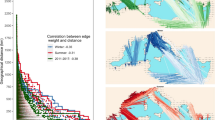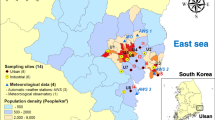Abstract
A scale-free network model with surface and vertical field measurements was used to identify the connectivity distribution of the scale-free network behavior of ambient volatile organic compounds (VOCs). The results show that the carbon number (C n ) with the total amount of C n compounds (P(C n )) possesses an explicit relationship with the scale-free network behavior. The proportionate coefficient (α) and exponent ( γ) of the scale-free network model with spatial and temporal variations are estimated and discussed. The analytical results demonstrate that although photochemical reactions cause the VOCs fraction variation, they do not alter the fraction of C n compounds observably. Therefore, the values of α and of γ did not vary with time, but with local regional characteristics. The results indicate that the influence of local VOCs emissions occurs at a height of 100 m, but becomes insufficient at a height of 300 m. Air mass mixing increases with greater height; thus, the influence of regional characteristics at a height of 700 m is low. Finally, a successful empirical model was established to evaluate the distribution of surface VOCs in various regions.







Similar content being viewed by others
References
Albert R, Barabási AL (2002) Statistical mechanics of complex networks. Rev Modem Phys 74:47–97
Atkinson K, Tuazon EC, Aschmann SM (1995) Products of the gas-phase reactions of a series of O3 with alkenes. Environ Sci Technol 29:1860–1866
Badol C, Locoge N, Léonardis T, Galloo JC (2008) Using a source-receptor approach to characterize VOC behavior in a French urban area influenced by industrial emissions part I: study area description, data set acquisition and qualitative data analysis of the data set. Sci Total Environ 389:441–452
Barabási AL, Albert R (1999) Emergence of scaling in random networks. Science 286:509–512
Barabási AL, Albert R, Jeong H (1999) Mean-field theory for scale-free random networks. Physica A 272:173–187
Bascompte J, Jordano P, Melián CJ, Olesen JM (2003) The nested assembly of plant–animal mutualistic networks. Proc Natl Acad Sci USA 100:9383–9387
Brulfert G, Galvez O, Yang F, Sloan JJ (2007) A regional modelling study of the high ozone episode of June 2001 in southern Ontario. Atmos Environ 41:3777–3788
Cavalcante RM, Campelo CS, Barbosa MJ, Silveria ER, Carvalho TV, Nascimento RF (2006) Determination of carbonyl compounds in air and cancer risk assessment in an academic institute in Fortaleza, Brazil. Atmos Environ 40:5701–5711
Davidson EH, Rast JP, Oliveri P, Ransick A et al (2002) A genomic regulatory network for development. Science 295:1669–1678
Doyle JC, Alderson DL, Li L, Low S et al (2005) The robust yet fragile nature of the internet. Proc Natl Acad Sci USA 102:14497–14502
Erdös P, Rényi A (1959) On random graphs. Publ Math 6:290–295
Erdős P, Rényi A (1960) On the evolution of random graphs. Publ Math Inst Hung Acad Sci 5:17–61
Gan F, Hopke PK (2003) Data mining of the relationship between volatile organic components and transient high ozone formation. Anal Chim Acta 490:153–158
Geng F, Zhao C, Tang X, Lub G, Tie X (2007) Analysis of ozone and VOCs measured in Shanghai: a case study. Atmos Environ 41:989–1001
Giot L, Bader JS, Brouwer C, Chaudhuri A et al (2003) A protein interaction map of Drosophila melanogaster. Science 302:1727–1736
Grosjean E, Deandrade AB, Grosjean D (1996) Carbonyl products of the gas-phase reaction of ozone with simple alkenes. Environ Sci Technol 30:975–983
Guenther A, Geron C, Pierce T, Lamb B, Harley P, Fall R (2000) Natural emissions of non-methane volatile organic compounds; carbon monoxide, and oxides of nitrogen from North America. Atmos Environ 34:2205–2230
Guimerá R, Amaral LAN (2004) Modeling the world-wide airport network. Eur Phys J B 38:381–385
Guimerá R, Mossa S, Turtschi A, Amaral LAN (2005) The worldwide air transportation network: anomalous centrality, community structure, and cities’ global roles. Proc Natl Acad Sci USA 102:7794–7799
Gupta ML, Cicerone RJ, Blake DR, Rowland FS, Isaksen ISA (1998) Global atmospheric distributions and source strengths of light hydrocarbons and tetrachloroethene. J Geophys Res 103(D21):28219–28235
Hakami A, Harley RA, Milford JB, Odman MT, Russell AG (2004) Regional, three-dimensional assessment of the ozone formation potential of organic compounds. Atmos Environ 38:121–134
Ho KF, Lee SC, Guo H, Tsai WY (2004) Seasonal and diurnal variations of volatile organic compounds (VOCs) in the atmosphere of Hong Kong. Sci Total Environ 322:155–166
Hoque RR, Khillare PS, Agarwal T, Shridhar V, Balachandran S (2008) Spatial and temporal variation of BTEX in the urban atmosphere of Delhi, India. Sci Total Environ 392:30–40
Hsieh CC, Tsai JH (2003) VOC concentration characteristics in Southern Taiwan. Chemosphere 50:545–556
Jeong H, Tombor B, Albert R, Oltvai ZN, Barabási AL (2000) The large-scale organization of metabolic networks. Nature 407:651–654
Jeong H, Mason SP, Barabási AL, Oltvai ZN (2001) Lethality and centrality in protein networks. Nature 411:41–42
Jordano P, Bascompte J, Olesen JM (2003) Invariant properties in coevolutionary networks of plant–animal interactions. Ecol Lett 6:69–81
LaCount DJ, Vignali M, Chettier R, Phansalkar A et al (2005) A protein interaction network of the malaria parasite Plasmodium falciparum. Nature 438:103–107
Lai LW, Cheng WL (2010) Urban heat island and air pollution: an emerging role for hospital respiratory admissions in an urban area. J Environ Health 72(6):32–35
Latella A, Stani G, Cobelli L, Duane M, Junninen H, Astorga C, Larsen BR (2005) Semicontinuous GC analysis and receptor modelling for source apportionment of ozone precursor hydrocarbons in Bresso, Milan, 2003. J Chromatogr A 1071:29–39
Luscombe NM, Babu MM, Yu H, Snyder M, Teichmann SA, Gerstein M (2004) Genomic analysis of regulatory network dynamics reveals large topological changes. Nature 431:308–312
Olson DA, Norris GA, Seila RL, Landis MS, Vette AF (2007) Chemical characterization of volatile organic compounds near the World Trade Center: ambient concentrations and source apportionment. Atmos Environ 41:5673–5683
Pankow JF, Luoa W, Benderb DA, Isabellea LM, Hollingswortha JS, Chena C, Ashera WE, Zogorskib JS (2003) Concentrations and co-occurrence correlations of 88 volatile organic compounds (VOCs) in the ambient air of 13 semi-rural to urban locations in the United States. Atmos Environ 37:5023–5046
Parra MA, González L, Elustondo D, Garrigó J, Bermejo R, Santamaría JM (2006) Spatial and temporal trends of volatile organic compounds (VOC) in a rural area of northern Spain. Sci Total Environ 370:157–167
Qin Y, Walk T, Gary R, Yao X, Elles S (2007) C2–C10 nonmethane hydrocarbons measured in Dallas, USA-Seasonal trends and diurnal characteristics. Atmos Environ 41:6018–6032
Ravasz E, Somera AL, Mongru DA, Oltvai ZN, Barabási A-L (2002) Hierarchical organization of modularity in metabolic networks. Science 297:1551–1555
Seco R, Peñuelas J, Filellaet I (2007) Short-chain oxygenated VOCs: emission and uptake by plants and atmospheric sources, sinks, and concentrations. Atmos Environ 41:2477–2499
Srivastavaa A, Josepha AE, Patila S, Morea A, Dixitb RC, Prakashb M (2005) Air toxics in ambient air of Delhi. Atmos Environ 39:59–71
Swanson AL, Blake NJ (2003) Seasonal variation of C2–C4 nonmethane hydrocarbons and C1–C4 alkyl nitrates at the Summit Research Station in Greenland. J Geophys Res 108(D2):4065
Theloke J, Friedrich R (2007) Compilation of a database on the composition of anthropogenic VOC emissions for atmospheric modeling in Europe. Atmos Environ 41:4148–4160
Wang HK, Huang CH, Chen KS, Peng YP (2010) Seasonal variation and source apportionment of atmospheric carbonyl compounds in urban Kaohsiung, Taiwan. Aerosol Air Qual Res 10:559–570
Watts DJ, Strogatz SH (1998) Collective dynamics of small-word networks. Nature 393:440–445
Acknowledgment
The funding support by the Environmental Protection Bureaus of Taichung County, Taiwan is highly appreciated. On December 25, 2010, Taichung County and Taichung City merged to form Taichung Municipality.
Author information
Authors and Affiliations
Corresponding author
Additional information
Responsible editor: Philippe Garrigues
Electronic supplementary material
Below is the link to the electronic supplementary material.
ESM 1
(PDF 463 kb)
Rights and permissions
About this article
Cite this article
Liang, CW., Ku, CK. & Liang, JJ. The scale-free network behavior of ambient volatile organic compounds. Environ Sci Pollut Res 20, 872–883 (2013). https://doi.org/10.1007/s11356-012-1199-z
Received:
Accepted:
Published:
Issue Date:
DOI: https://doi.org/10.1007/s11356-012-1199-z




